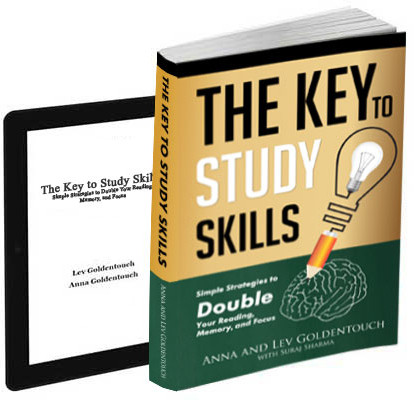On day one, almost all of our students wanted to see the training schedule that would take them to their goal. Previously, we tried to control the selection of options to funnel all students through the same resources. Currently, we are widening the arsenal of training tools you can use.
Introduction
- Take our books on Amazon. We assume that you have some experience with speed reading and memorization training. You need a more detailed guide with examples of how to solve specific exercises effectively and deal with everyday issues. If you need further resources, please take a look at our services.
- Watch all videos. If you use one of the links in the services to get a video course, please binge-watch all the videos to get some background regarding the topics that will be discussed. Only then start systematic learning. Please note that we recommend only the products we know to be helpful, but have no creative control over the materials that do not have the keytostudy logo.
- Define your goals and schedule. How fast do you want to read, and how well do you want to retain what you read? The qualifying baseline of 1000 words per minute, with 80% retention, usually requires six weeks of intense training, which means four sessions per day. With relaxed training, which means one session per day, six months is more realistic. You must have at least 30 minutes of daily computer or mobile app practice. You are also likely to read for at least 60 minutes daily.
- One-on-one training over Skype. After three weeks of independent training, many people have one-on-one coaching sessions with Anna over Skype. Please read here and here. The sessions are not cheap; you are expected to have two monthly sessions. Contact me at [email protected] to discuss the details.
- Getting extra background. Go to our blog section and check the subjects. Read several posts. Try to search this keytostudy blog with different keywords to satisfy your curiosity. Some posts are helpful later in the course if you do not understand what you read now. We have over 900 articles that should cover all your questions, some of which are long. Tell me if we should discuss some additional subjects.
- Understand what Pomodoro time means. Read this post. You are expected to take a ~5-minute rest for each ~25 minutes of training. Make sure your eyes get rest during that time. Other details appear in various posts on this blog.
- Start training. The most addictive and simple exercise we can offer is visual short-term memory training. Train it daily for 15 minutes. At each stage of the course, you will get another perspective on this exercise and use a different strategy.
- Apply for beta testing. Our best resources and offers are reserved for our beta testers: people who are courageous enough to try the resources in making. Please contact me to apply for beta testing.
- Get the reading apps. This guide is supposed to work online anywhere, so I did not cross-reference the mobile apps to see if there were alternatives. As new apps are released and old websites die, some links may become unstable. If you see that some of the references are too old and do not work, or if you need to find new resources and want my opinion, contact me at [email protected]. You should use Acceleread on iOS and Speed Reading Trainer on Android for speed reading.
NOTICE: If you’re looking for information on any topic, there’s a good chance you’ll find an article on this blog. Feel free to use the site’s search function, and if you don’t find what you’re looking for, don’t hesitate to reach out.
👉 Join our thriving Facebook community and grow alongside like-minded learners who value critical thinking and deliberate practice.
Week 1: Learning the basics
- Visualization practice. Try to enjoy the first week of training. You are expected to start working on visualization and memory, but first, you must get used to training your brain. Do not try to get a lucid image for abstract notions; instead, try to figure out what sort of imagery comes naturally as your visual associations.
- Proposed daily training:
10 min relaxation visualization: visualize a pleasant and friendly environment. Try to imagine as many details as you can. Alternatively, practice focusing on visualization.
10 min create visual markers for abstract stuff
15 min practice linking markers
10 minutes to learn more about yourself - Additional training games:
Spot the difference games improve your concentration and focus.
Standard memory games are also important.
Some freestyle training here and here.
No timing on these games. It is essential to have fun 🙂 - Target: You will know you are ready to move on when you can easily create visual markers and want to practice the skill on real things.
Week 2: Train visualization and memory
- Visualize objects. You may continue with more detailed visualizations. One way to improve the visualizations is to move to PAO representation. Visualize a person acting with an object.
- Proposed daily training:
20 minutes daily to improve your visualization
20 minutes daily to memorize and remember images
20 minutes daily to memorize words
These are good exercises. Anna urges them to do them all the time. However, after week 2, the students are advised to practice these exercises only 5- 10 minutes daily. - Additional training games:
This game trains you to remember images using associations.
Habituate using markers for everyday memory items (meeting people, distractions, etc)
Do practice when you travel
Try to push your memory limits by multitasking computations - Target: You will know you are ready to move on when you can create visual markers with ease and for abstract ideas. Check out this article to see the level of complexity you will need to handle.
- Dictionary: For some words, you can generate quick visualizations; other words will be more complex. Start reusing the visualizations using your mnemonic dictionary.
Week 3: Starting to work with texts
- Learn SQ3R. What you do next is read the text paragraph by paragraph: preread, read, and summarize from memory until you get almost 100% retention, like the retention you want your lawyer to have when representing you in court.
- Proposed daily training:
Spend a full hour daily reading texts paragraph-by-paragraph and remembering as many details as you can.
You can use reading with a card.
You need to remember all the numbers within the text without mistakes. You will also need to remember all the names without mistakes. And finally, you will need to recite the content with great clarity. You can select words for initial visual markers and then gradually improve the quality of the visual markers. - Additional training ideas:
Occasionally, we suggest annotating the text [no preference for annotation tools, as long as they allow free drawing] and drawing your markers near the paragraphs. Do this for 2-3 days, but not afterward.
You can start with Wikipedia texts, but they are much denser than you encounter in real life. After 2-3 days of Wikipedia reading, it is best to change to something simpler. Typically, we suggest reading texts on Reddit or coming up with our texts.
For Wikipedia texts, you will need 1-2 markers per sentence; for a regular text, you will need 1-2 markers per paragraph.
If you need a challenging text, try my old book or my other old book. They will challenge your attention to detail and ability to remember large amounts of information. - Optional training
Since it takes some time to get 100% retention (hint: more than a week), we add some attention to improving games to increase our retention:
This exercise assigns colors to text, making it easier to find differences. Later, you can apply the same technique to the texts you read, like here.
This exercise starts to prepare you for the things to come. - Target:
You know you are ready to move on when you remember 90% of the text you read without any mistakes. Use this tool to verify.
Week 4: Starting speed reading – subvocalization
- Suppress vocalization.
We assume that at this point the student visualizes fast and almost effortlessly and can remember 90% of what they read using visual markers without errors.
DO NOT PROCEED WITH SUBVOCALIZATION UNTIL YOU REMEMBER 90% OF THE TEXT. Now it is time to speed things up. The practice is straightforward. During the practice, you will lose some retention and slowly regain it. If, after two weeks of practice, your retention does not recover, please do not speed up and consider contacting me. - Proposed daily training:
If you do not do visual short-term memory training, you should start doing it.
20 min per day practice reading with subvocalization suppression. Please note that when you suppress vocalization, your retention percentage drops significantly and rises gradually within the next 2 weeks.
20 min per day, scroll through text at high speed. At this point, you can still control the speed at which you read. - Additional training ideas:
You could also revisit the old articles on recommended subjects.
At this point, your mental age should start changing, so have fun checking it. - Target:
You are ready to move on when you sub-vocalize less than 10% of the text.
Week 5: Speedreading – saccades
- Assumptions
At this point, you can read the text virtually without subvocalization.
You should start working on saccades.
Use this cheatsheet to verify the saccade size. - Proposed daily training:
The main exercise here is a sliding words display. It is a great exercise: simple and addictive. Do it as much as you can.
Also, you really should use Spreader software for your device. Other good alternatives are Acceleread and Reading Trainer.
10 min per day, try reading running text. You do not control the speed anymore!
10 min per day do visual angle training using speedreading Shultz tables.
10 min per day train multicolumn saccades - Target:
Start working from 3 columns to 1 column. Hint: It takes more than a week.
You are ready to move on when you text almost effortlessly. Advanced students can read texts 12 words wide and five columns high without moving their eyes. It takes approximately four months of training to achieve this.
Week 6:
- Book reading.
You measure how long it takes to read a page from a chosen book, say X seconds.
Now you read 5 pages x2 speed, 3 pages at x1.5 speed, and 5 pages at x1.2 speed.
Repeat the process for an hour. Do it daily for a week.
Also, read this article. - Everyday training
Now you can start spicing up your training using simple exercises in your everyday routine.
You should also monitor your reading speed and practice the relevant exercises until you reach 1000wpm with 85% comprehension. Usually, it happens around week 10. - Some simple exercises you can do without a computer
Do these exercises whenever you want. - Advanced memorization. If you did not take a section of the course, please do.
This exercise may help you with memory palaces.
This exercise may help with podcasts and conversations.
This exercise may help you with faces.
This and this exercise may help you belong to the 2% of humanity that can multitask efficiently. [No promises here: you will need many additional skills] - Consider advanced training
We offer various kinds of advanced training in our masterclasses. Go back to our services page and consider the options.
Next:
You might feel your training is over, but it is only beginning. You are ready to start your masterclasses. Start with memory. The recommended order is:
- Memory – advanced memory subjects
- Speedreading – advanced speedreading subjects
- Speedwriting – for really long-term retention
- Research – to assess the reliability of what you read
- Anchoring – to deal with psychological issues like objections or anxieties
- Teaching – to learn by teaching others
- Productivity – to achieve the “flow” state reliably
- Investment – to choose worthy goals and learn patience
You may need two years to complete these masterclasses and integrate what you learned into your life.

Get 4 Free Sample Chapters of the Key To Study Book
Get access to advanced training, and a selection of free apps to train your reading speed and visual memory

